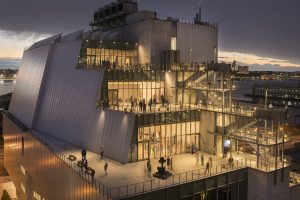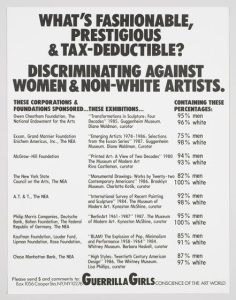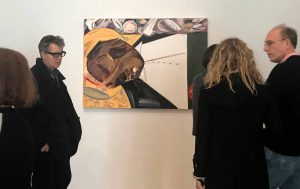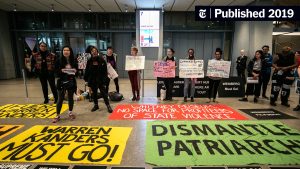Saptarshi Ghosh
The Whitney Biennial is one of the most popular and globally significant art shows, organised by the Whitney Museum of American Art in New York City. Featuring art of lesser-known contemporary American artists, it is a trendsetter in the world of art and has been responsible for bringing artists like Georgia O’Keefe, Jeff Koons and Jackson Pollock to the limelight.
The Whitney Museum of American Art
The Whitney Biennial started out as an annual event in 1932; the first Biennial was organised in 1973. Despite being at the forefront of the American art world, the event has also courted a fair number of controversies over the years.
The 1980s
The lack of representation of women among the displayed artists had been an issue raised intermittently against the Biennial during the 1970s and the 80s, despite occasional efforts on the part of the organisers to rectify it. For example, in the 1979 show, one-third of the artists were women.
In 1987, the Whitney Biennial came under fire since only 24 per cent of the displayed artists were women. The Guerrilla Girls, an anonymous group of feminist artists, responded to this disproportionately low representation by staging ‘The Guerrilla Girls Review the Whitney’ downtown at the Clocktower, where they displayed graphs and charts specifying the representation of women and minorities in biennials since 1973. In consequence, for its next iteration, the museum raised the number of women to 40 per cent.
Protest posters by the Guerilla Girls
Courtesy: Whitney Museum of American Art
The 1990s
The 1991 and 1993 Biennials attracted criticism for their confrontational and aggressive political themes. The 1991 Biennial, for example, tackled pressing issues of the time, like AIDS, race and gender. Conservative critics rued that the event was more preoccupied with voicing political concerns than the quality of the displayed art. Attacking the curatorial decision-making, they complained about how artists were selected on the sole criteria of how political their art was and not on the basis of any artistic mettle.
The 1991 Biennial, despite being heavy on themes of social justice, had only a 10 per cent representation of non-white artists. In contrast, the 1993 edition became one of the most diverse exhibits by a major American museum until then, with a strong focus on women and gay artists.
Pat Ward Williams’ photomural which was on display in the 1993 Biennial
Courtesy: Gilroy Centre for the Arts
Upon entering the display, visitors were greeted by photographer Pat Ward Williams’ photomural featuring five Black youths, with the following words spray-painted on it: “What You Lookn At”. Museum tags designed by the artist Daniel Joseph Martinez were handed out to the attending visitors which read, “I can’t imagine ever wanting to be white.” Janine Antoni and Matthew Barney had also put on their display of provocative body art; there was also a film by Saddie Bening on lesbian lovers.
The art historian Robert Hughes lambasted the exhibition for not giving prominence to painting. Attacking the “wretched pictorial ineptitude” of the artists, he even disparaged the Biennial’s focus on “exclusion and marginalization … [in] a world made bad for blacks, Latinos, gays, lesbians and women in general”. Roberta Smith complained in her New York Times article that the show was “less about the art of our time than about the times themselves”. In the same newspaper, the critic Michael Kimmelman was far more blunt in expressing his disapproval: he simply wrote, “I hate the show.”
In hindsight, the 1991 and 1993 Biennials were far too ahead of their time for trying to inculcate a political consciousness in the curatorial process. The displayed art and explored themes proved to be too provocative for conservative American tastes.
The Past Decade
In recent times, the Whitney Biennial has frequently landed in the soup for a variety of reasons. In 2017, Dana Schutz’s painting Open Casket drew the ire of visitors for its portrayal of the dead body of a Black teenager named Emmett Till, who was lynched in Mississippi in 1955. There was a heated debate on whether the painting should be allowed to hang as part of the exhibit. It did however stay put through the run of the show.
Open Casket by Dana Schutz on display in the 2017 Biennial
Courtesy: The Nation
The 2019 edition of the Biennial opened despite nine weeks of continuous protests led by a group called Decolonize This Place, who demanded that Warren Kanders, a vice chairman of the Whitney Museum, step down. This was in response to reports that canisters of tear gas made by Kanders’ company Safariland had been tossed at refugees seeking asylum at the Tijuana-San Diego border in November 2018. When several artists, like Korakrit Arunanondchai, Meriem Bennani, Nicole Eisenman and Nicholas Galanin, announced that they would not be participating in the Biennial as a result, Kanders was forced to step down from the board.
Protesters agitating for the removal of Warren Kanders in front of the Whitney Museum, 2019
Courtesy: The New York Times
In 2020, the Whitney Museum had to cancel its exhibition Collective Actions: Artist Interventions in a Time of Change owing to backlash from Black artists. The exhibition was meant to showcase works of artists belonging to “collectives to raise funds for anti-racist initiatives, including criminal justice reform, bail funds, Black trans advocacy groups and other mutual aid work”. Several Black artists alleged that the museum had acquired their artworks from fundraising sales meant to benefit racial justice causes. These artists had either donated their works to the fundraising sales or sold them at a discounted price.
While some felt that this amounted to theft, others argued that this was part of the larger pattern of exploiting Black artists by underpaying them. The exhibition itself came to be seen as an insincere co-option of the Black Lives Matter movement.
The 2022 edition
Despite the mounting woes in recent years, the 2022 Whitney Biennial thankfully remained scandal-free. Titled Quiet As It’s Kept and curated by David Breslin and Adrienne Edwards, it featured a significant turnout on its preview night!
Bibliography:
- https://museemagazine.com/culture/art-2/features/a-brief-history-of-the-whitney-biennial-americas-most-controversial-art-show
- https://en.wikipedia.org/wiki/Whitney_Biennial#:~:text=In%201987%2C%20the%20show%20was,its%20alleged%20sexism%20and%20racism.
- https://newcriterion.com/issues/1991/6/aoeculture-under-siegeathe-politics-of-the-whitney-biennial
- https://www.theguardian.com/artanddesign/2020/aug/29/whitney-museum-black-artists-controversy
- https://www.theartnewspaper.com/2020/08/26/whitney-museum-cancels-show-following-artists-accusations-of-exploitation
- https://hyperallergic.com/510834/whitney-biennial-boycott-response/
https://www.vanityfair.com/style/2022/03/whitney-biennial-2022











